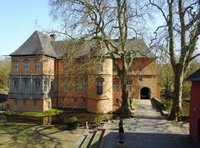Die Haltung für das Römerglas, die sogenannte Römerschraube, stammt mit hoher Wahrscheinlichkeit aus Norddeutschland oder den Niederlanden. Zu sehen ist ein aufspringendes Pferd, gestützt auf einen Baumast. Zwischen den Vorderhufen ist der Kelchhalter arretiert, bestehend aus einer dreiteiligen, verschiebbaren Halterung, die jeweils in einem Greifkopf endet. Diese Halterung dient als Stütze für das Römerglas. Das Pferd ist auf dem metallenen Stützfuß montiert. Dieser ist sechsseitig und filigran abwechselnd mit Vogel- und Tiermaskendekor verziert.
en

